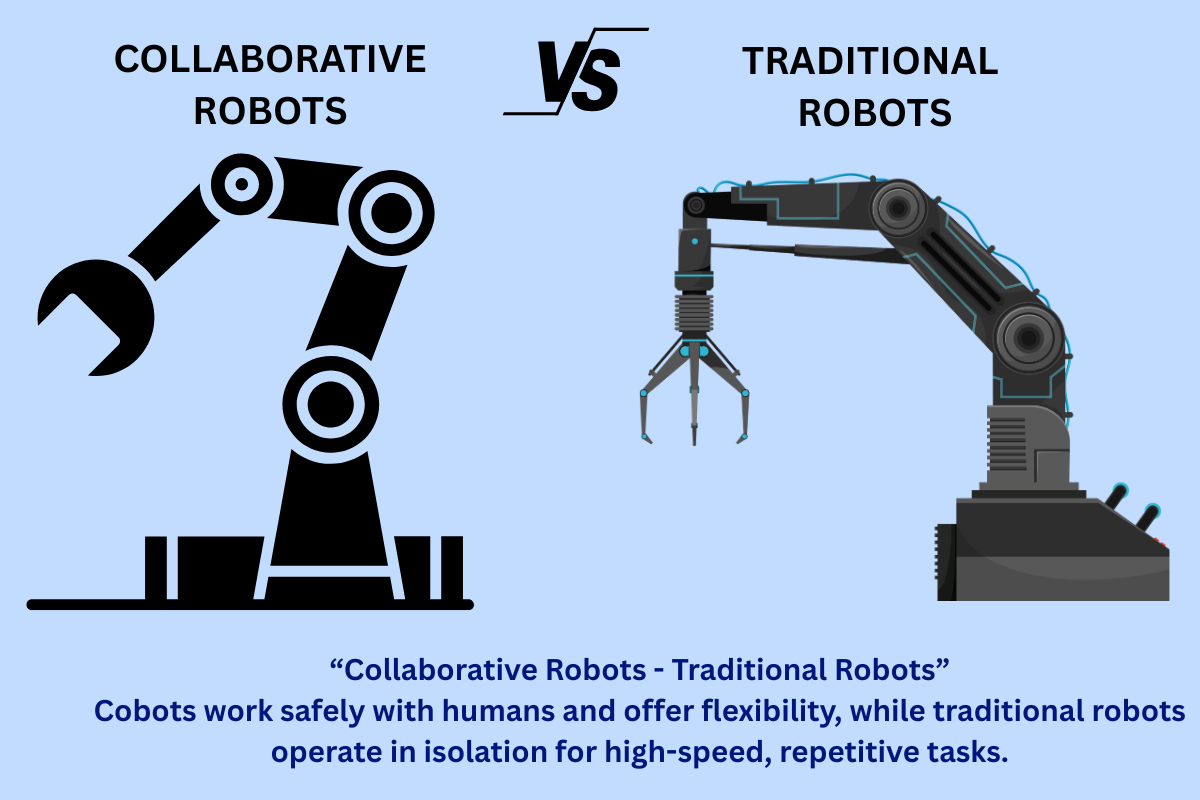
21 Jul What Is a Cobot and How Is It Different from a Traditional Robot?
What Is a Cobot and How Is It Different from a Traditional Robot?
A collaborative robot, or cobot, is a type of robot designed to work safely alongside humans in shared workspaces. Unlike traditional industrial robots, which typically operate in isolated, fenced-off areas due to safety concerns, cobots are equipped with advanced sensors, force-limiting technology, and user-friendly interfaces that allow them to interact directly with human workers.
Cobots are ideal for tasks such as machine tending, assembly, packaging, and quality inspection—especially in environments that require flexibility and frequent changeovers. They are easy to program, quick to deploy, and cost-effective, making them an attractive solution for small and medium-sized enterprises.
In contrast, traditional robots are built for high-speed, high-volume, and highly repetitive tasks. They require complex programming, significant infrastructure, and strict safety measures, making them best suited for large-scale manufacturing settings like automotive or heavy industries.
The key difference lies in collaboration versus isolation. Cobots enhance human capabilities and improve safety and efficiency without replacing human workers, while traditional robots are optimized for automation in structured environments with minimal human involvement.
As industries strive for smarter, more flexible automation, one term has gained significant traction in recent years: cobot, short for collaborative robot. Unlike traditional industrial robots that operate in isolation, cobots are designed to work alongside humans, enhancing productivity, safety, and agility on the factory floor. But what exactly sets a cobot apart from a traditional robot? Let’s break it down.
Understanding Cobots: The Collaborative Workforce
Cobots are next-generation robots developed to interact directly with human workers in a shared workspace. Their design philosophy centers around ease of use, adaptability, and safety. They come equipped with advanced sensors, AI algorithms, and force-limiting technology that allow them to detect human presence and respond appropriately—either by slowing down, pausing, or stopping entirely if a person gets too close.
Key characteristics of cobots include:
- User-friendly programming: Often with drag-and-drop interfaces or hand-guiding.
- Safe design: Built-in safety features eliminate the need for physical barriers.
- Compact and lightweight: Easily integrated into existing workflows.
- Quick deployment: Faster to set up and redeploy than traditional systems.
Traditional Robots: Power and Precision in Isolation
Traditional industrial robots have been a mainstay in manufacturing for decades. Known for their speed, strength, and accuracy, these robots excel in environments where repetitive, high-volume tasks are performed under consistent conditions. However, they typically require:
- Physical safety enclosures to prevent injury.
- Complex programming and engineering for setup and maintenance.
- Dedicated floor space, making them less flexible for dynamic manufacturing needs.
Traditional robots are best suited for large-scale production lines in industries like automotive, electronics, and heavy machinery—where human interaction is minimal or strictly separated.
The Key Differences: Cobot vs. Traditional Robot
| Feature | Cobots | Traditional Robots |
|---|---|---|
| Interaction with humans | Designed for safe, direct collaboration | Requires physical separation for safety |
| Safety systems | Built-in sensors and force limiters | External cages and barriers |
| Programming | Intuitive, low-code or no-code interfaces | Complex programming required |
| Deployment | Easy to install, move, and reprogram | Requires expert integration |
| Flexibility | Ideal for small-batch and variable tasks | Optimized for high-volume, repetitive tasks |
| Cost-effectiveness | Lower total cost of ownership (especially for SMEs) | Higher upfront and maintenance costs |
The Future of Automation: Collaboration Over Isolation
The rise of cobots reflects a broader shift in industrial automation—from full replacement of human labor to augmented collaboration. Cobots do not aim to eliminate jobs but rather to enhance human capabilities, taking over repetitive or ergonomically challenging tasks and allowing workers to focus on more skilled, creative, or supervisory roles.
Industries like electronics, pharmaceuticals, food processing, and even logistics are embracing cobots for tasks such as:
- Machine tending
- Assembly
- Packaging
- Quality inspection
- Pick and place operations
Conclusion: Choosing the Right Robot for the Job
While traditional robots continue to play a vital role in large-scale automation, cobots are opening new doors for small- to medium-sized enterprises (SMEs) and companies seeking flexibility and human-robot collaboration. Understanding the distinct advantages of cobots over traditional robots is key to making informed automation decisions that boost productivity, safety, and innovation.
For more insights, visit www.strategiautomation.com — your go-to source for automation trends and solutions.

No Comments